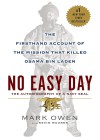No Easy Day: The Firsthand Account of the Mission that Killed Osama Bin Laden
Written by: Matt Bissonnette (alias Mark Owen),
Dutton Adult, 2012,
ISBN 9780525953722, 316pp
Reviewed by: Lieutenant Jacob Choi
No Easy Day is one of the many stories told in the aftermath of the manhunt for Osama Bin Laden. Although it seeks to clarify some of the misinformed reporting in the days that followed the ‘raid of the 21st century’, the author makes it clear that he had a defined target audience in mind — a demographic not unlike the high school student he once was, aspiring to be a US Navy SEAL.
With that in mind, the book is written for the common reader. Military slang and acronyms are explained within a style of writing that reflects a military memoir trying to connect the dots of the news flashes common in the popular media. ‘Mark Owen’, later revealed to be Matt Bissonnette, begins the story with a portrayal of his early life, guiding the reader through his upbringing in Alaska, through DEVGRU selection and into the missions that defined recent SEAL history.
Rather than delivering a full dissection of the raid to kill Bin Laden, Bissonnette spends time lamenting bureaucratic stalling, not unlike that evident prior to the successful rescue of Captain Richard Phillips in the MV Maersk Alabama hijacking. Readers seeking a memoir detailing the tactics of the Bin Laden raid may be disappointed to find that the author confirms what the media previously reported. The key players on the ground were unaware that one of the helicopters had crashed — this may have been an elite team, but it was not immune from the effects of the chaos of war.
The author has since cast off his pseudonym and has been identified as one of three assaulters who were first on the floor to see the dead Osama Bin Laden. However his account has recently been criticised, apparently by some of his teammates and a number of Pentagon officials. For the discerning reader, this story is worth reading in conjunction with other accounts of the same raid as told in Zero Dark Thirty and an account in Esquire magazine of ‘The Shooter’, another SEAL in the raid.
For those who are curious about the inner workings of the intelligence gathered for the raid, the book presents an overview of the techniques that were combined to provide the 100% assurance required for confirming the target. Bissonnette writes that the intelligence deduced a great deal of information about the target compound that was eventually confirmed in the air assault. He also highlights the intensity of training and simulation for the raid, culminating in a full rehearsal performed in front of senior military leaders.
One theme that Bissonnette emphasises closer to the end of the book involves what he refers to as the ‘good idea fairy’, a notional character that represents bureaucratic attempts to unnecessarily complicate the mission. The SEALs are subject to ideas generated from higher levels that understandably frustrate the men, particularly given the extent of collective experience evident in this hand- picked team. Most ideas involve contingency planning and are clearly well- intentioned, and the SEALs treat the majority with a degree of humour.
Readers may wonder how the American government planned to handle the diplomatic ramifications of the raid into Pakistan (a friendly ally) should it be compromised, as it represented a clear intrusion into Pakistani sovereign territory. The answer from higher up, according to the author, was that two dozen SEALs, an interpreter and an assault dog had been sent in to recover a downed UAV.
Military readers will appreciate the humour, frustration and excitement as Bissonnette shares his experiences in training, operations and everyday life. He tells readers that SEALs are still ordinary humans who are misunderstood by the outside world. He writes of his team returning home from the Bin Laden raid to resume family life without their spouses realising the extraordinary enormity of their actions.
Although the world now understands more about Operation Neptune Spear, the unique perspective offered by No Easy Day highlights what makes the Bin Laden raid as remarkable as the Entebbe hostage rescue (Operation Thunderbolt by Israeli forces) and the Iranian Embassy siege (by British SAS forces). It allows the reader to gain a unique insight into the SEAL community, while also preserving the mystique traditionally associated with the personalities and activities of such teams.
That mystique is deliberately preserved by the author so as to build aspiration within his younger readership. His avowed intention was to write a piece of recruitment literature for another high school boy who would dream of becoming a special forces operative. As military members, this is a story well worth reading as it adds to the lessons we can learn from others in uniform.


